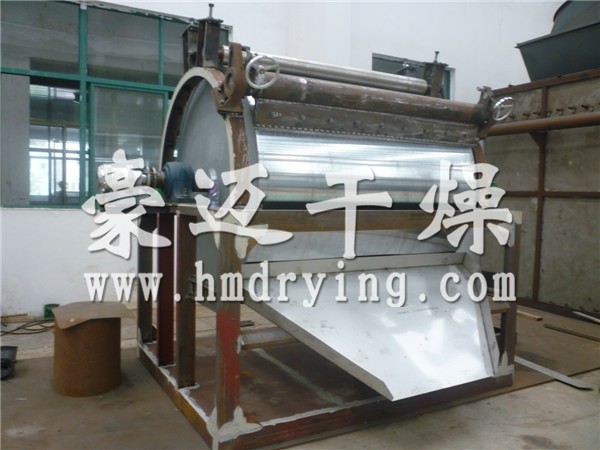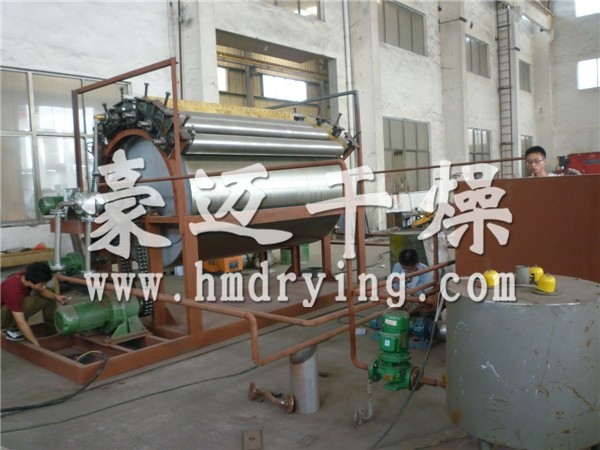Description
Rotary drum drying calcining kiln for iron phosphate
Key words: dedicated iron phosphate calcining kiln, iron phosphate rotary drum dryer, rotary drum dryer, iron phosphate dryer, iron phosphate calcination kiln
Classification: Battery engineering industry
Case overview: according to the requirements of ferric phosphate calcination provided by customers, combined with our long-term experience in drying industry, a set of drying and calcining equipment is recommended, including 1.3x18m rotary drum dryer and a set of 600000 kcal gas furnace. The design concept of the whole system is to use the residual heat of the calcined crystal water on the surface water attached to the material at the feed end, which can more effectively achieve energy saving and fully achieve the utilization rate of heat
Project Overview:
Material name: iron phosphate
Dry weight: 10000kg / day
Initial material content: 20% and 2 crystal water
Final content: anhydrous
Drying and calcining temperature: 300-500 ℃
Heat energy of calcination: natural gas
Material: the front section 8m is 321 (high temperature part), and the rear end is made of stainless steel 304
According to the above customer requirements, combined with our long-term experience in drying business, we recommend a set of drying and calcining equipment as 1.3x18m rotary drum dryer and a set of 600000 kcal gas furnace. The design concept of the whole system is to use the residual heat of calcined crystal water to remove the surface water attached to the material at the feed end, which can more effectively achieve energy saving and fully achieve the utilization rate of heat, and can be in place in one step, which can greatly reduce the labor force.
Related design of iron phosphate rotary drum dryer:
1. The main drive speed regulating motor of the drum adopts gear open drive, and the lower part is designed with oil tank to realize oil immersion lubrication and stable and safe operation. The gear is made of 45 ᦇ cast steel and heat treated, and the idler is made of 45 ᦇ cast steel. It can control the circular motion and residence time more effectively.
2. The whole system adopts countercurrent drying, which can more effectively remove the internal crystal water and ensure the final moisture control of the whole material.
3. The bag filter is used in the collection part, because there is less material in the air flow, and more than 99% of the material can be recovered. Because the fineness of the material is relatively fine, the filter bag adopts the composite membrane, so as to increase the filtering area and collect the material more effectively.
4. The kiln head and tail adopt double-layer seal, the first-class carbon silicon aluminum composite plate high-temperature seal, plus the second-class fish scale seal, can react in a closed container, and can play a more effective role in drying and calcining.
Special calcining kiln for iron phosphate:
rotary drum dryer is a kind of calcination equipment with high degree of mechanization. The resistance of fluid passing through the cylinder is small, the energy consumption is low, and the adaptability to materials is relatively strong.
according to the requirements of calcination, after the raw materials are put into operation from one end of the dryer, the materials are evenly distributed and dispersed in the dryer, and fully contact with high-temperature flue gas, so that the water adsorbed on the surface of iron phosphate powder is decomposed, and the steam after decomposition is discharged by a dehumidification fan, so as to meet the drying requirements. Then, anhydrous iron phosphate (containing two crystal water) is made. In the process of calcination, the material stays in the kiln for a period of time under the action of the inclined cylinder and the plate, and moves to the other section of the calcining kiln to discharge the finished product, The internal crystallized water migrates out within the temperature and time control, and is collected by the first-class bag to ensure dust recovery. Using the heat of natural gas combustion as the heat source of drying equipment can fully improve the heat utilization rate.
Key words: dedicated iron phosphate calcining kiln, iron phosphate rotary drum dryer, rotary drum dryer, iron phosphate dryer, iron phosphate calcination kiln
Classification: Battery engineering industry
Case overview: according to the requirements of ferric phosphate calcination provided by customers, combined with our long-term experience in drying industry, a set of drying and calcining equipment is recommended, including 1.3x18m rotary drum dryer and a set of 600000 kcal gas furnace. The design concept of the whole system is to use the residual heat of the calcined crystal water on the surface water attached to the material at the feed end, which can more effectively achieve energy saving and fully achieve the utilization rate of heat
Project Overview:
Material name: iron phosphate
Dry weight: 10000kg / day
Initial material content: 20% and 2 crystal water
Final content: anhydrous
Drying and calcining temperature: 300-500 ℃
Heat energy of calcination: natural gas
Material: the front section 8m is 321 (high temperature part), and the rear end is made of stainless steel 304
According to the above customer requirements, combined with our long-term experience in drying business, we recommend a set of drying and calcining equipment as 1.3x18m rotary drum dryer and a set of 600000 kcal gas furnace. The design concept of the whole system is to use the residual heat of calcined crystal water to remove the surface water attached to the material at the feed end, which can more effectively achieve energy saving and fully achieve the utilization rate of heat, and can be in place in one step, which can greatly reduce the labor force.
Related design of iron phosphate rotary drum dryer:
1. The main drive speed regulating motor of the drum adopts gear open drive, and the lower part is designed with oil tank to realize oil immersion lubrication and stable and safe operation. The gear is made of 45 ᦇ cast steel and heat treated, and the idler is made of 45 ᦇ cast steel. It can control the circular motion and residence time more effectively.
2. The whole system adopts countercurrent drying, which can more effectively remove the internal crystal water and ensure the final moisture control of the whole material.
3. The bag filter is used in the collection part, because there is less material in the air flow, and more than 99% of the material can be recovered. Because the fineness of the material is relatively fine, the filter bag adopts the composite membrane, so as to increase the filtering area and collect the material more effectively.
4. The kiln head and tail adopt double-layer seal, the first-class carbon silicon aluminum composite plate high-temperature seal, plus the second-class fish scale seal, can react in a closed container, and can play a more effective role in drying and calcining.
Special calcining kiln for iron phosphate:
rotary drum dryer is a kind of calcination equipment with high degree of mechanization. The resistance of fluid passing through the cylinder is small, the energy consumption is low, and the adaptability to materials is relatively strong.
according to the requirements of calcination, after the raw materials are put into operation from one end of the dryer, the materials are evenly distributed and dispersed in the dryer, and fully contact with high-temperature flue gas, so that the water adsorbed on the surface of iron phosphate powder is decomposed, and the steam after decomposition is discharged by a dehumidification fan, so as to meet the drying requirements. Then, anhydrous iron phosphate (containing two crystal water) is made. In the process of calcination, the material stays in the kiln for a period of time under the action of the inclined cylinder and the plate, and moves to the other section of the calcining kiln to discharge the finished product, The internal crystallized water migrates out within the temperature and time control, and is collected by the first-class bag to ensure dust recovery. Using the heat of natural gas combustion as the heat source of drying equipment can fully improve the heat utilization rate.






